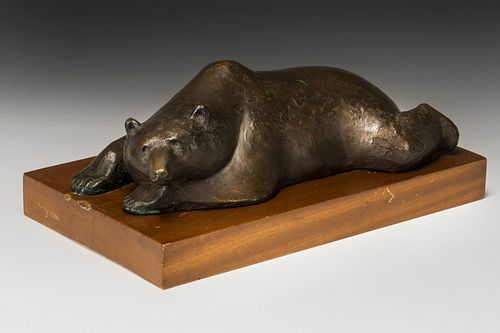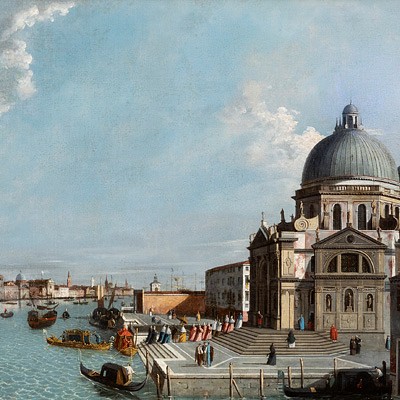JOSEP CAÑAS I CAÑAS (Banyeres del Penedés, Tarragona, 1905 - El Vendrell, Tarragona, 2001). "Bear lying down." Bronze sculpture on a wooden base. Sign
Lot 24
About Seller
Setdart Auction House
Carrer Aragó 346
Barcelona
Spain
Setdart Subastas was born in 2004 and is currently the first online art auction in Spain with solidity, prestige and reliability guaranteed by our more than 60,000 users. Setdart has a young, dynamic and enterprising team ready to successfully manage the purchase and sale of art works through custom...Read more
Estimate:
EUR€1,000 - EUR€1,200
$1,075.27 - $1,290.32
Absentee vs Live bid
Two ways to bid:
- Leave a max absentee bid and the platform will bid on your behalf up to your maximum bid during the live auction.
- Bid live during the auction and your bids will be submitted real-time to the auctioneer.
Bid Increments
| Price | Bid Increment |
|---|---|
| EUR€0 | EUR€10 |
| EUR€200 | EUR€25 |
| EUR€500 | EUR€50 |
| EUR€1,000 | EUR€100 |
| EUR€3,000 | EUR€200 |
| EUR€5,000 | EUR€500 |
| EUR€10,000 | EUR€1,000 |
| EUR€20,000 | EUR€2,000 |
| EUR€50,000 | EUR€5,000 |
About Auction
By Setdart Auction House
May 18, 2021
Set Reminder
2021-05-18 09:30:00
2021-05-18 09:30:00
America/New_York
Bidsquare
Bidsquare : Classics XIX and XX
https://www.bidsquare.com/auctions/setdart-auction-house/classics-xix-and-xx-6961
The next 18th May there will be a 19th and 20th Century Classics Auction at Setdart.com There will be a select repertoire of important artists such as Carlos Cruz Diez, Luis Feito, Joan Miró, Fernando Botero, Josep Llimona, Salvador Dalí among others. Setdart Auction House sofia@setdart.com
The next 18th May there will be a 19th and 20th Century Classics Auction at Setdart.com There will be a select repertoire of important artists such as Carlos Cruz Diez, Luis Feito, Joan Miró, Fernando Botero, Josep Llimona, Salvador Dalí among others. Setdart Auction House sofia@setdart.com
- Lot Description
JOSEP CAÑAS I CAÑAS (Banyeres del Penedés, Tarragona, 1905 - El Vendrell, Tarragona, 2001). "Bear lying down." Bronze sculpture on a wooden base. Signed on the left side. Measurements: 12 x 20 x 37 cm (sculpture) and 4 x 22 x 39 cm (base). A self-taught draughtsman and sculptor, Josep Cañas took some courses at the Escuela de Artes y Oficios de Villanueva y la Geltrú, and soon came into contact with artists such as Damià Torrents and Joaquín Mir. In 1925, after a period in Sitges, Cañas settled in Barcelona, where he joined the Círculo de Sant Lluc and the Real Círculo Artístico, being a member of the board of directors of the latter. During these years he devoted himself to landscape painting, and in 1927 he took part in the Second Art Exhibition of the Penedès, held in El Vendrell. He also dedicated himself to theater during these years, and in 1927 he premiered his first play. Two years later he took part again in the Penedès Exhibition. In 1930 he set up his first studio in Barcelona, thanks to a grant from the Diputació de Tarragona, and in 1932 he held his first individual exhibition in the Sala Parés. From these years on, Cañas showed his work regularly at the Salón de Montjuic. In 1935 he is granted a travel grant by the Generalitat, which allows him to travel to London to visit the British Museum, and later to Paris. On his return, in 1937 he was appointed secretary of the Casal de Cultura de Cataluña, although he declined the appointment to go to fight on the Ebro front. There, however, he did not enter combat, but dedicated himself to making the models commissioned by the General Staff. Once the war was over, in 1942 he won the prize for sculpture at the National Exhibition of Fine Arts, and the Museum of Modern Art in Barcelona acquired one of his works. The following year he works with Ignacio Zuloaga, and in 1947 he holds an exhibition at the Museum of Modern Art in Madrid, in which the Institute of Hispanic Culture acquires one of his works to take him to America. He then embarks accompanying the work, which is installed in Carmel, California. In this same city he will hold an exhibition of works made there, the following year. He then travels to Mexico, where he stays for several years and holds several exhibitions of his work, held between Mexico and New York. In 1954 he exhibited at the National Museum of Anthropology in Mexico, and the following year he left the country to participate in the Hispano-American Biennial held in Barcelona, where he was given a room of his own. Once settled in Spain again, he continues to exhibit his work in prestigious galleries such as the Parés in Barcelona, the O'Hana in London or the Museum of Modern Art in Madrid, and to carry out important commissions for the Museum of Geneva and other important clients. In 1957 he won a medal at the National Exhibition of Fine Arts, and in 1964 he inaugurated the relief "La Sardana" in the Retiro Park in Madrid, commissioned by the Casal Català of this city. His public and official recognition will only grow, books are published with his work and he is awarded honors such as the Cross of Sant Jordi of the Generalitat de Catalunya, in 1986, or the appointment of illustrious son of his hometown. In 2001 the house where he was born was fitted out as a museum, where the four stages of his work can be observed chronologically. He is currently represented in the Library of Catalonia, the Museums of Contemporary Art of Barcelona, Bilbao and Madrid and in the Anthropological Museum of Mexico, among other public and private collections.
- Shipping Info
-
In-House Shipping
-
- Buyer's Premium



 EUR
EUR CAD
CAD AUD
AUD GBP
GBP MXN
MXN HKD
HKD CNY
CNY MYR
MYR SEK
SEK SGD
SGD CHF
CHF THB
THB















